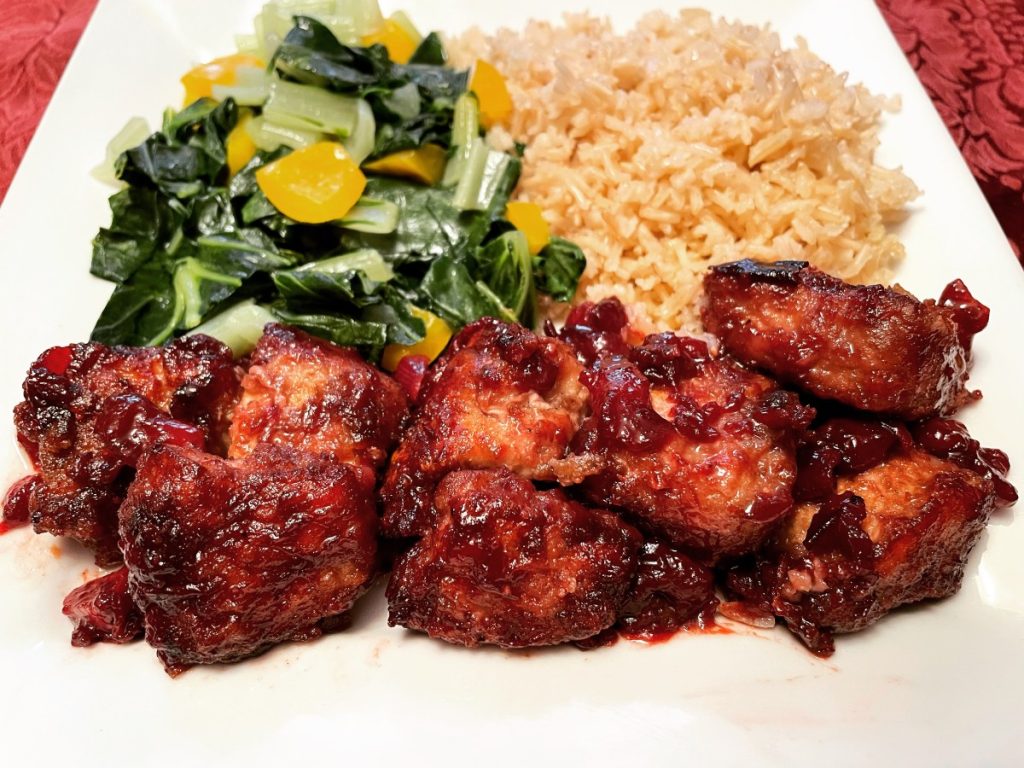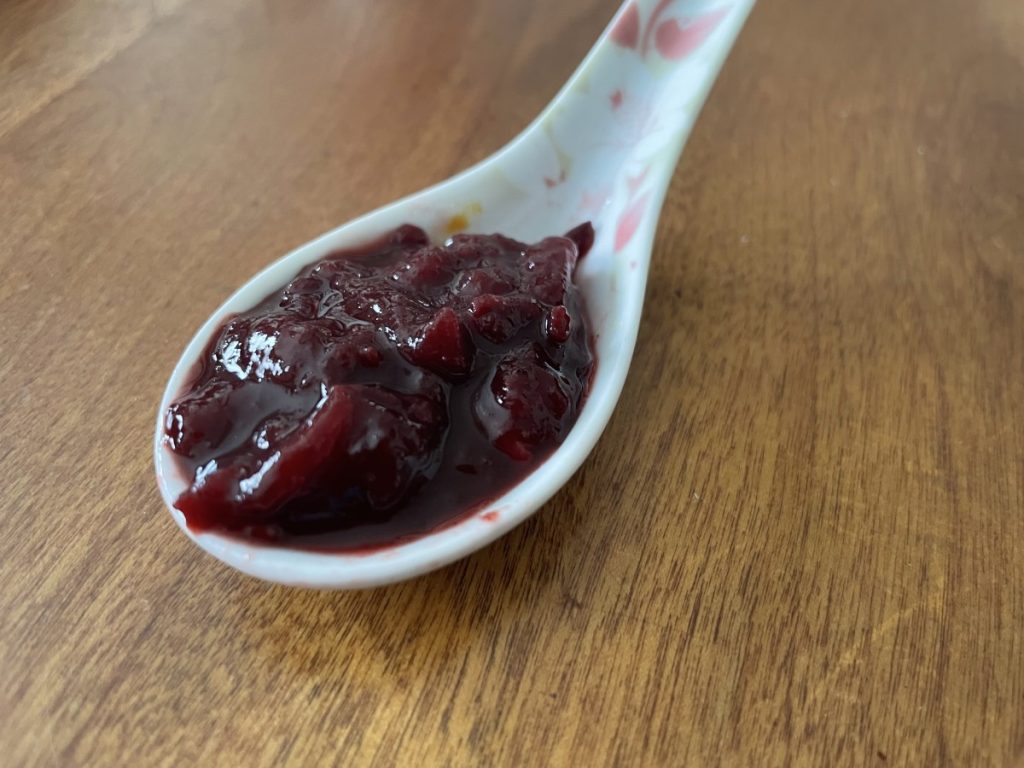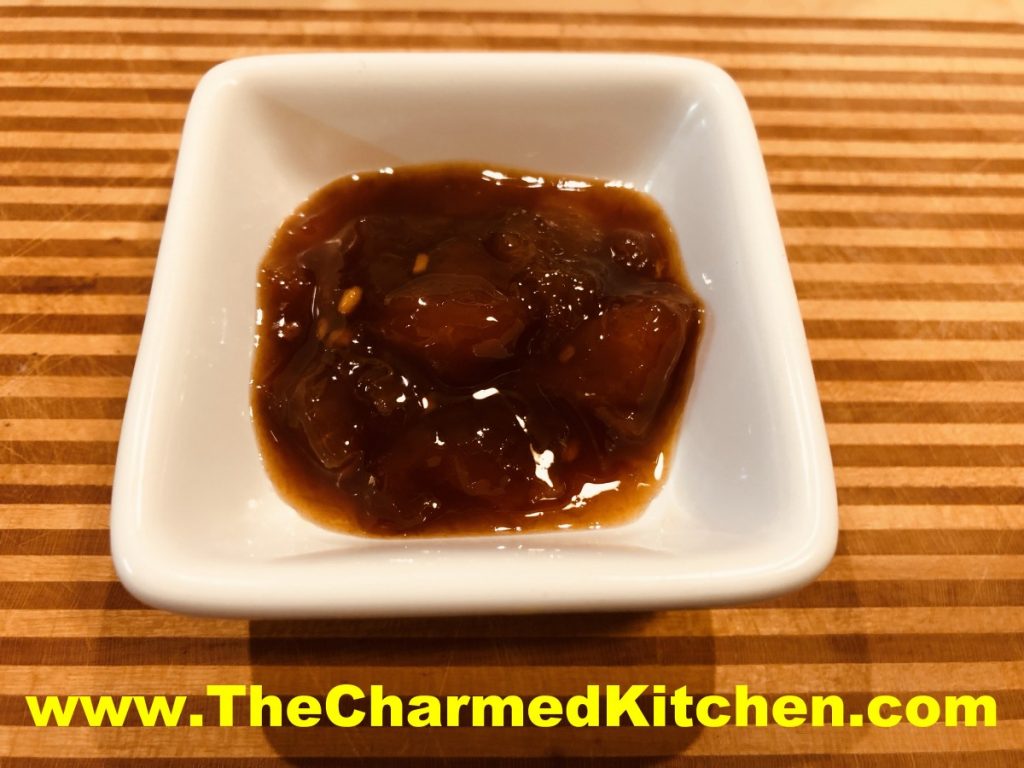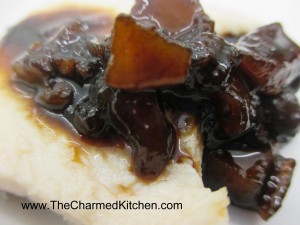Pork with Plum Chutney

I had very ripe plums and wanted to use them in a savory dish rather than a dessert. I had made a pear chutney before, so that gave me the idea of using the plums in a chutney. I had some pork loin defrosted and I thought they would work well together. I was not disappointed.
I started by pitting and chopping up the plums. They were very ripe. I say in the recipe it was 2 cups, but let’s say a generous 2 cups. You can be off a little bit here. A few more plums aren’t going the hurt anything. I threw everything in a pot and let it cook until the mixture thickened. After it was finished I added a little honey because it seemed too tart. Trust your taste here for how much sweetening it needs.
Here is the recipe for the chutney and for the pork.
Plum Chutney
2 c. pitted chopped plums
1 small onion, minced
4 cloves garlic, sliced thin
¼ c. balsamic vinegar
¼ c. brown sugar
2 T. honey
1 t. cinnamon
Salt, pepper and cayenne to taste
Combine all ingredients, except the seasonings in a medium saucepan and s= cook over medium heat until thickened. This took about 20 minutes, maybe a bit longer. As the mixture gets thicker, stir more often to prevent sticking. I added the honey later as the chutney seemed too tart when it was finished. That is partly based on how sweet the fruit is and your personal taste. Makes about 2 cups. Will keep in fridge for weeks. Great on pork, duck and chicken or served with cheese and crackers as an appetizer.
Pork with Plum Chutney
1 lb. boneless pork, cubed
2 T. cornstarch
2 T. sherry, not cooking sherry
1 T. soy sauce
Oil
Additional cornstarch for dredging
Salt and pepper
About ¾ c. plum chutney
Place cubed pork in a small bowl and combine with the cornstarch, sherry and oil. Chill several hours, if possible. Heat oil in skillet. Dredge the pork in cornstarch and sauté until cooked through. Season with salt and pepper and spoon any excess oil out of the pan. Add the chutney and simmer until heated through. Serves 3-4.

Fresh Peach Chutney

Peaches are in season and I am loving it. Besides eating them fresh, I have been enjoying them in all sorts of dishes. Peach jam, peach ice cream, peach scones…. the list goes on.
This chutney is one more way to take advantage of peach season. Chutney is a dish that walks the line between savory and sweet. I made this batch a little spicy. The heat pairs well with the sweetness of the fruit. Feel free to adjust heat to suit your own taste.
You can serve this chutney like a relish, on the side. Or, use it like a sauce, adding to meats when cooking. Another option is to use it as a glaze, brushing it on meats while baking or grilling. A vegetarian option is brushing it on grilled portobello mushrooms or eggplant slices.
I have served chutney with a cheese board, too. Fun and easy addition to the appetizer menu.
So here is the recipe.
Fresh Peach Chutney
5 medium peaches, peeled, pitted and diced
1 medium onion, peeled and chopped fine
½ c. cider vinegar
½ c. sugar
½ c. water
2 T. honey
2 T. lemon juice
2 T. minced garlic
1 T. soy sauce, or a little more to suit your taste
½ t. red pepper flakes, or more for a spicier chutney
1 T. cornstarch
2 T. cold water
Combine all ingredients in a saucepan, except cornstarch and the 2 tablespoons of cold water, and cook over medium heat until peaches are tender and onion is translucent, about 15 minutes. Stir occasionally to avoid burning. Combine cornstarch with the cold water and stir until smooth. Slowly add to simmering chutney while stirring constantly. Mixture will thicken. Adjust seasonings, if needed. Makes about 3 cups. Will keep in fridge a couple of weeks- can be frozen.
Serve with pork or lamb. Great with duck or chicken, too. You can also serve as an appetizer with cheese and crusty bread.
Saving Specialty Ingredients

We all have certain ingredients that fall into this category. You might use it once in a great while, or only in one recipe. Then you have extra, but aren’t sure what else to do with it, or how to keep it from going bad. These ingredients are often expensive, and can be at waste of money to just toss.
There are a couple of ways to handle the situation. You can find more uses for the product or find ways to make it keep longer. So let discuss a few products and how you can get more from them.
Capers: The buds from the caper bush, capers come pickled and are salty and similar in flavor to gherkins. Probably most often used in tartar sauce they can be used lots of other places. Since they taste like intense little pickles use them where you might use pickles. Capers are great in potato salad, chicken, tuna or ham salads and in eggs dishes and omelets. They also go great with seafood. I love to add a few capers when I enjoy lox on a bagel. Once open, they are kept in the fridge and will keep for a very long time.
Tomato Paste: Think of tomato paste as super concentrated tomato sauce. Strong in flavor a little goes a long way. How many of us have opened a jar for the one tablespoon of tomato paste a recipe calls for, and then end up throwing the rest away when we find it in the back of the fridge weeks later looking like a science experiment gone bad? You can get tomato paste in squeeze tubes that keep longer in the fridge or you can freeze it. That seems to be the easiest solution. Put dollops of tomato paste in ice cube trays and freeze. Once frozen you can pop out the cubes, place them in little freezer bags, label, and toss back in the freezer. Now when you need that tablespoon of tomato paste- you’ll have it.
Chutney: This fruit- based relish is used in Indian dishes. Most often made with mangoes. It can be used in tuna and chicken salad. You can use chutney as you might use cranberry sauce as a side dish or to glaze meats. A mix of fruit, garlic, vinegar, sugar and spices it has a complex flavor. I use it in bobotie- a North African casserole. It is one of those items that you might use a couple of times and then forget about. Because of its sugar and vinegar base it will keep for a pretty long time in the fridge. Like tomato paste you can freeze the chutney in smaller amounts and defrost for later use. What’s better though is to start to use it more. Try adding it to sauces or even make a salad dressing with some chutney in it. Chutney can be a great base for a sweet and sour sauce for meats or veggies.
Ginger: This versatile root can be grated in everything from savory to sweet dishes. Although often associated with Asian cooking, ginger is used in all sorts of foods. I get this question all the time. How do I keep my fresh ginger root longer? Some people like to peel it and place it in a jar of sherry and keep it in the fridge. You can also save peeled garlic cloves this way. But I prefer to just freeze it. Take the whole ginger root and place in a freezer bag. I like to keep mine on the freezer door so I can find it easily. When ready to use, just scrape off the peel, like you might on a carrot. Use a grater on the ginger while it is still frozen and return the unused portion to the freezer. It will keep for a very long time this way- as long as the ginger is in a freezer bag. You can even slice and chop the frozen ginger- although I must admit that is a little trickier. Next time you are making gingersnaps try using the fresh/frozen ginger over the dried version. Another option is to candy the ginger. Here is the recipe.
Candied Ginger
6-8 oz. fresh ginger
¾ c. water
¾ c. sugar, plus extra for rolling
3 T. light corn syrup
Remove peel from the ginger. Slice into disks, about ¼ -inch thick. Place ginger in a pot with cold water and bring to a boil. Boil 1 minute, drain and rinse under cold water. Repeat process 2 more times. Return to pan with fresh water and boil 15 minutes. Drain and pat dry. Bring ¾ c. water and ¾ c. sugar to boil in sauce pan with the corn syrup. Boil 2-3 minutes and then add the ginger. Simmer, stirring occasionally until all but a spoonful of the syrup is left. This should take about 10 minutes. On a wax-paper lined baking sheet sprinkle 1 cup of sugar and arrange the ginger slices on top of the sugar. Toss around until cooled, adding more sugar if needed. Place on a drying rack for 24 hours before storing. Makes a little over ½ pound.
Buttermilk: I buy fresh buttermilk always planning on baking more with it. I do not like to just drink it. That leaves me with unused buttermilk. I hate just pouring that money down the drain. I freeze it! Keep in mind it will separate when thawed- but you can still cook and bake with it. Another easy solution is to buy powdered buttermilk and just mix up what you need. Yet another answer is to make your own- well, sort of. Just use regular milk in the recipe but add some acid to it to make it curdle. I use lemon juice- but vinegar works well, too. If the recipe calls for a cup of buttermilk- measure out the cup of milk just a little short-leaving room for the extra liquid. 1-2 tablespoons of lemon juice or vinegar per cup of milk will work fine.
Tahini: I first started using tahini when I made my own hummus. Tahini is like peanut butter, but made with sesame seeds. I only needed a small amount and then found myself with this open jar of tahini. I never seemed to use it in anything else. While tahini keeps for a long time, I never felt comfortable using tahini that had been opened for more than a few months. I found freezing tahini was a decent solution. I just put it in a small plastic container and popped in in the freezer. When I needed it, I would just spoon out what I needed. You can also make your own tahini when you need some. Just combine sesame seeds in a blender with a small amount of oil. I normally add 1/4 cup of sesame seeds and a couple tablespoons of olive oil. Avocado oil works well, too. You can add more oil, if needed. I finally started using tahini in other ways. Its a great base for salad dressing. Here is the salad dressing recipe.
Tahini Dressing
1/3 c. tahini
1/3 c. water
¼ c. oil, optional
1/4 c. lemon juice
2 garlic cloves, chopped
3/4 t. salt
Combine all ingredients in a blender until smooth. Use on green salads or on fish dishes and falafel.
Note: You can add a little more lemon juice to this recipe when using on seafood dishes.
Whipping Cream: While not an exotic ingredient, I find I rarely need the whole pint that I bought. So many recipes call for smaller amounts. Unless I am making dessert for a crowd, I know some of the whipping cream will go to waste. Once the carton is open, you have to use it fairly soon. You can use it in coffee, or in your cooked oatmeal or cereal to replace some of the liquid. You can use to make French toast or custard. Another solution is to freeze what you can’t use right away. Once it is frozen, the thawed whipping cream won’t whip like before. But you can still cook with it. You can make ice cream with it, too. Below is a recipe for making chocolate ice cream, but you can add other flavors to your whipped cream, like jams or preserves. If you have an open container, you will likely have less than a full pint. Just whip up what you have, and flavor to taste.
Super Easy Homemade Chocolate Ice Cream
1 pint whipping cream
1/2 c. chocolate syrup or to taste
Place whipping cream in a bowl and whip until stiff peaks form. With mixer running, add the syrup. Add until mixture is the color of chocolate ice cream. You can also give it a taste, to be sure. Place mixture in a container with a tight fitting lid and place in freezer. Freeze several hours before trying it. Makes 1 quart.
Pear Chutney
I call this dish by a couple of names. It was given to me as a pear sauce. I think it makes people think of apple sauce and that is misleading. This flavorful sauce is more like a glaze or chutney. A mix of savory and sweet flavors it is great served on the side with various dishes and can be used as a glaze. The picture does not do it justice. We had this in a class recently and I served it with roast turkey. Everybody loved it. It goes well with pork and duck, too. I always make a double batch and freeze some for later use. The recipe follows along with a recipe using the chutney with pork. I think you will be surprised at just how tasty this stuff is.
Pear Chutney
½ c. sugar
½ c. balsamic vinegar
1 lb. Pears, cored, peeled and diced
2 T. dried minced onion
1 t. minced garlic
1 t. hot sauce – or more to taste
pinch cinnamon
salt and pepper to taste
Combine all ingredients in a saucepan and cook over medium heat until thickened, about 20 minutes. Stir often to avoid burning. Serve with pork or lamb roasts. Also great with turkey or duck. Makes about 2 cups.
Pork with Pear Chutney
1 lb. Pork loin. Sliced or 4 pork chops
oil
1 large onion, sliced
salt and pepper to taste
1 recipe pear chutney, See above
In skillet cook pork in oil, turning to brown evenly until juices run clear when meat is pierced. Remove meat and add onions, sautéing until onions are browned. Return pork to pan, adjust seasonings and add 1 cup of the pear chutney. Cook 10 minutes, or until heated through and bubbly. Serves 4.




